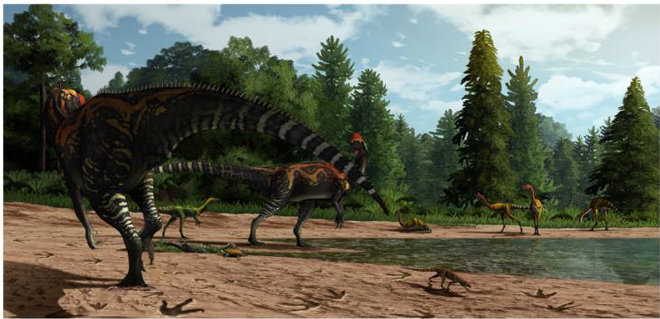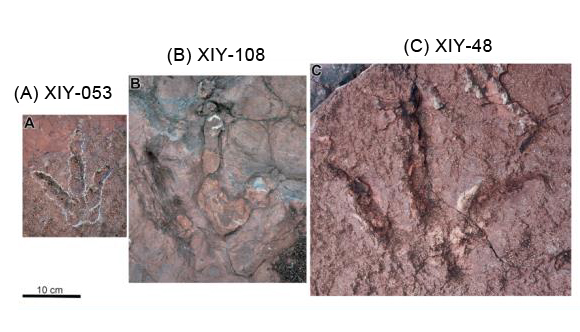Scientists writing in the on-line, open access, academic journal “PeerJ” have reported upon the discovery of over 100 dinosaur fossil footprints. The footprints represent theropod dinosaurs and they vary in size indicating that a variety of meat-eating dinosaurs co-existed in the late Early Jurassic of Yunnan Province, China.

Yunnan Province Dinosaurs
Yunnan Province in south-western China is famous for its dinosaur fossils, the majority of which are body fossils, but there have been several published papers detailing track sites and more trace fossils from this province are due to be reported upon. The theropod assemblage track site is located close to the village of Xiyang, Jinning County in central Yunnan. The strata in which the tracks are located come from the Lower Jurassic Fengjiahe Formation and represent a lakeside environment (lacustrine). The reddish mudstone deposits that contain the tracks also preserve mud cracks that suggest the area was subject to droughts. The palaeoenvironment is believed to have been humid and warm (sub-tropical to tropical).
Theropod Tracks
The tracks have been known about for twenty years, but only recently has the site been extensively studied. Unfortunately, several prints had been lost to erosion prior to detailed analysis.

Solitary Coelophysoid and Tetanuran Theropods
The Xiyang track site preserves 120 exposed footprints made by solitary theropod dinosaurs as they visited the lakeside. It is the largest theropod track site in terms of the total number of prints found, described to date from Yunnan. The prints have been assigned to three broad groups based on their size, they indicate that a variety of theropods were present in the ancient ecosystem including coelophysoid as well as larger tetanuran theropods.
The largest print from the site (XIY-48) measures 39 cm long and 40 cm wide. Large claw marks are associated with each digit of this print. Fossils of the six-metre-long theropod Sinosaurus triassicus (formerly Dilophosaurus sinensis), are known from this area. Sinosaurus fossils from Lower Jurassic Fengjiahe Formation have been found around 500 metres away from the track site, it has been speculated that the largest print could represent a track made by a Sinosaurus, although as it is a footprint, it has been assigned to the ichnogenus Kayentapus.

Classifying the Footprints
Although the size of any tracks left can be influenced by many factors, the research team conclude that at least three different kinds of theropods were visiting the site frequently. The three groups of prints that the tracks have been classified into are:
- Morphotype A (>8 cm to <21 cm) resembling the ichnogenus Grallator.
- Morphotype B (>27 cm to<30 cm) identified as the ichnospecies Kayentapus xiaohebaensis.
- Morphotype C (39 cm) an isolated print referred to the ichnogenus Kayentapus.

Large Predator Dinosaurs Rare in the Early Jurassic
In Yunnan, the majority of dinosaur fossils from Lower Jurassic rocks represent sauropodomorphs. Whilst the tracks of sauropodomorphs can be mistakenly identified as theropod prints, the researchers who include Hongqing Li of Yunnan University and Claire Peyre de Fabrègues (Department of Biology, Indiana University of Pennsylvania, USA), as well as colleagues from Yuxi Museum (Yunnan Province) and the Chinese Academy of Sciences are confident that this site provides a useful record of the diversity of meat-eating dinosaurs present in this region during the late Early Jurassic
Large terrestrial predators (animals in excess of five metres in length), are rare in Early Jurassic ecosystems. Large tracks are scarce at this site, but not absent. Carnivorous dinosaurs of all sizes presumably co-existed in this palaeoenvironment and were regular visitors to the lakeside in search of food or potential prey.
The scientific paper: “The largest theropod track site in Yunnan, China: a footprint assemblage from the Lower Jurassic Fengjiahe Formation” by Hongqing Li, Claire Peyre de Fabrègues, Shundong Bi, Yi Wang and Xing Xu published in PeerJ.
Visit the Everything Dinosaur website: Dinosaur Models and Toys.






Leave A Comment